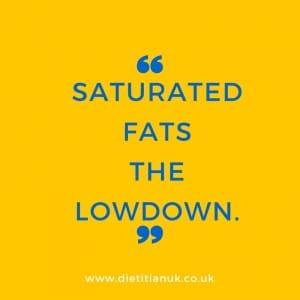Recently the world of fat had a shaking up. For 50 years saturated fat has been the bad guy, linked to coronary heart disease. But a systematic review and meta-analysis of the research looked at 32 worldwide cohort studies that reported finding a link between saturated fat (SFA) and coronary heart disease (CHD) and begged to differ.
The original landmark research that led to the development of our dietary guidelines was done by Ancel Keys, the Seven Countries study in the 1970s. He found links between CHD and cholesterol levels and linked this to saturated fats as we know saturated fats increase cholesterol. However this was not actually proven and no research was done to then prove the association or to look at the impact of the dietary guidelines.
The new analysis found that:
- Saturated fat, omega 6 fatty acids, and monounsaturates (MUFA) were not linked to heart disease but instead they were neutrally related to the risk.
- Trans fats were associated with a 16% increased risk of coronary events, a 34% increases in all cause mortality, 28% increase of CHD mortality and 21% increased in risk of CHD.
- Omega 3’s led to a reduced risk.
The research analysed in these studies was carried out using diet history questionnaires and diet records and we know this is not always ultra-reliable. There is always the potential for bias and under/over-reporting. Different studies also used different views on fat categories so it confuses the results slightly.
What has happened: Some of the research looking at saturated fats compared extremes of intake. When you reduce saturated fats you increase polyunsaturated and monounsaturated fat, or you increase carbohydrates. The research often doesn’t tell us what foods were changed if saturated fat levels were altered.
What are Saturated Fats and how much should we eat?
The fats found in animal products: butter, cows milk,meat, salmon and egg yolks and in Plant products: chocolate, cocoa butter, palm oil.
Dietary guidelines are that saturated fats should be limited to <10% and trans fats to <1% of energy. These still stand.
Research in 2005 showed us that replacing SFA with carbohydrates caused a small increased heart disease risk and instead should be replacing it with polyunsaturated fats (PUFA). Another study looks at the quality of carbohydrate, which I think is the key. It found replacing SFA with high glycemic index carbs led to a higher risk.
If you replace saturated fats with high glycaemic index carbohydrates, the “bad LDL cholesterol” increases. There is a direct association between LDL cholesterol and heart disease mortality. What we replace saturated fats with is important. Highly processed CHO are known not to be good for us due to their effect on blood sugars.
A 2% increase in energy from trans fats is associated with a 25% increase in risk of CHD and 3% increase in CHD mortality. So we don’t want to be eating more of those.
Current recommendations are that we replace SFA with PUFA and not with refined carbohydrates. So there is still am emphasis on lowering saturated fat but not going for very low fat diets. We all need some fats in our diet and very low fat diets are no longer recommended.
PUFA’s are found in:
High quality carbohydrates from fruit and veg and grains.
Nuts, seeds and plant oils.
Omega 3’s – 2 portions oily fish or vegetarian options such as linseed, hemp oil, walnuts and chia.
Can SFA’s be good for us?
Some foods that contain saturated fats also have other goods nutrients: vitamin A, D calcium and phosphorus are in dairy foods for example. Vitamin D is a nutrient that we are finding more people are deficient in so we do want people to be eating full fat dairy.
It’s a complex relationship to understand. There are so many confounding factors when we look at diet and heart disease, you cannot control them all.
We know now that dietary fats have different biological effects. Not all SFA’s behave in the same way. So it looks like excess lauric, myristic and palmitic acid are shown to decrease LDL cholesterol clearance which is not a good thing, but other length fatty acids are not associated with CVD risk.
All saturated fats are nutrients with very specific functions, we metabolise them differently and synthesise fatty acids when we eat sugars, alcohol and starch. So SFA is not the only thing responsible for heart disease risk.
It is more complex than we originally gave it credit for.
The concern is that is we remove one nutrient it gets replaced with something else that may not be as good.
So it’s not all about reducing SFA but more key is what we replace it with. It’s not the cutting down that is always key but what we increase and actually eat more of. Perhaps our dietary guidelines should look at what to EAT MORE of rather than the negative EAT LESS.
Individual changes to one nutrient have a knock on effect on another. WE want to see the bigger picture here and look at the balance of the whole diet. Maybe look at what you shold eat more of and not what to reduce. as you eat more fruit and ve you will eat less processed foods.
References:
BMJ 2015;351:h3978 SFA meta-analysis
http://www.ncbi.nlm.nih.gov/pubmed/19211817
http://www.ncbi.nlm.nih.gov/pubmed/20375186
The saturated Fat debate. Jenny Rosborough. Complete Nutrition Vol 7 (No2) June 2015


